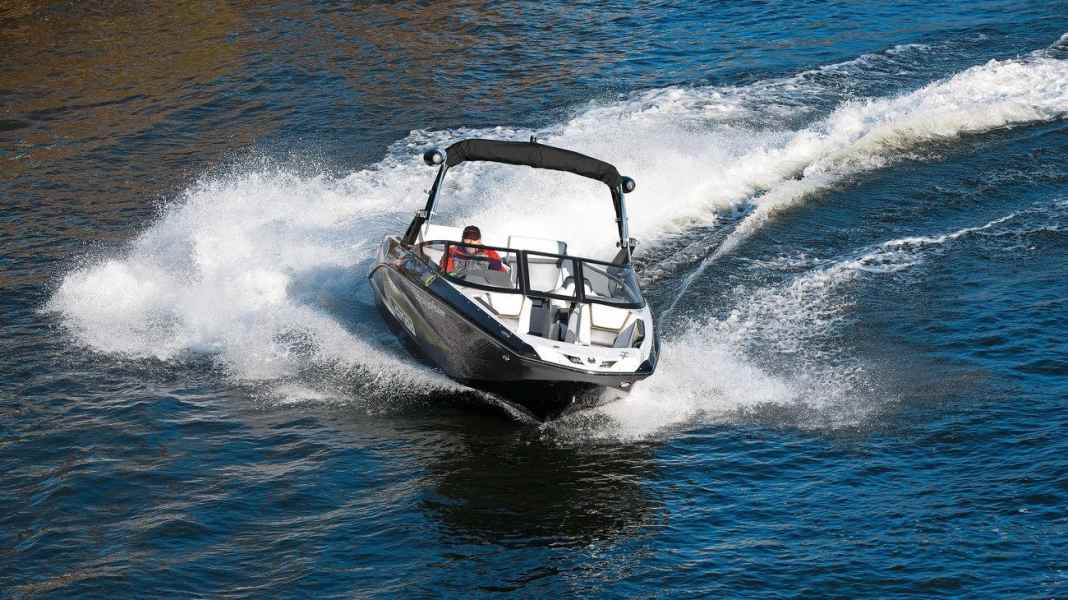
A 21-foot boat with 500 hp and jet propulsion!Connoisseurs will remember Art Carlson, who made jet propulsion socially acceptable in the late 1970s with Glastron-Carlson boats and in particular with his CVX-20, literally bringing tears to the eyes of many pleasure boaters.
Aware of this, we climb into the Scarab 215 HO Impulse - and realise,that the adrenaline is still pumping when you push the throttle forwards in one go and water is pumping through two nozzles behind you at a maximum speed of 8000 rpm,while the pointer of the analogue speedometer moves inexorably towards the 60 mph mark or the digital central instrument rattles swiftly towards 92 (km/h).
As long as the driver keeps a low profile and operates the rudder and throttle gently, you won't notice much of this as a passenger; the boat is then suitable foralso for families or for wakeboarding or waterskiing.
However, if the skipper succumbs to the power, i.e. the horsepower, the 215 HO becomes the ultimate heartbeat accelerator. To do this, however, he must have sharpened all his senses - and forget everything he knows about the handling of conventional boats with an outboard or inboard motor.
Apart from the sliding steps on the hull, there is nothing in the water that can guide the boat. The most important things are the throttle and the rudder. Jet skiers know this.And basically, the 215 HO is also a jet ski in terms of its genes, but a very comfortable one in which you can sit comfortably with several people.
Like a jet ski, the boat is steered solely by thrust,i.e. with the two water jets that flow out of the aft nozzles and are directed using the rudder. This makes it possible to make turns with normal radii, but also extremely small ones that correspond to the length of a boat and resemble a pirouette.The interplay between rudder angle and boat movement is therefore perfect.Good to know, for example to avoid an obstacle that suddenly appears. The centrifugal forces acting on the occupants are bearable, as the hull does not hook in or rock significantly.
Driving backwards? This is due to the flaps behind the nozzles, which deflect the water jet more or less strongly.
Depending on the current of the water, this can be programmed on the dashboard so that the boat can stand on the spot with the gear lever in the neutral position - a great feature. But what can drive you to despair when mooring, casting off or slipping isthat when travelling in reverse, you do not travel in the direction in which you turn the rudder, but in the opposite direction. You get used to it over time.
On the other hand, it is possible to switch from forward to reverse gear while travelling - something that only works well with a jet drive. With the 215 HO, it is thus possible to increase the speedreduce from top speed (92 km/h) to 8 km/h within about 120 m - shorter is not possible. And the waves produced by commercial shipping on the Main can be managed without any problems. If you are travelling parallel to waves, for example at the stern of boats ahead, you have to use the throttle and rudder,so that you are not deflected by the stern wave.
What runs through? At slow speed - less than 1800 rpm is not possible due to the system - one tank of fuel at 4 knots is theoretically enough for a distance of 147 nm plus 15% reserve.
The test boat starts planing at 8 knots, while both Rotax engines are turning at 4000 rpm. With 1000 rpm more, at 25 kn, it is economical according to our measurement data. One tank of petrol is then sufficient for 97 nm of non-stop sailing plus reserve.The 215 HO therefore fulfils our minimum range requirement. If you want to savour the revs to the full, you have to look for a refuelling option after about 46 nm if you want to keep the reserve. Then the acoustics also become a problem. Our sound pressure level meter shows 86 dB(A) at 5000 rpm with an increasing tendency.
Skipper and co. sit comfortably and safely in appropriately dimensioned bucket seats.Reflections in the windscreen and instruments impair the otherwise good foresight.Otherwise, there is nothing else to criticise about the driving position. Guests sit either on the U-shaped cockpit bench or in the bow, where they can hold on to suitably mounted handles.
Four strokes, three cylinders, dual-circuit cooling, one turbocharger: This adds up to 250 hp with jet propulsion. Two such engines are installed, but we only see one throttle.
The solution:Both motors are monitored and controlled solely by the computer.Among other things, it also regulates the cruise control. Most of the technology is located under the rear bench sunbed. But in view of this, we will limit ourselves to general visual inspections and checking the oil levelsand leave the rest to the service technician.We did not discover any essential equipment such as a manual bilge pump, fuel tap or fuel pre-filter - but we did discover an automatic fire extinguisher in the engine tank compartment.
In terms of workmanship, there is not much to criticise. There is only room for optimisation here and there, for example when closing the engine compartment flap. The Impulse version we drove already comes with a number of accessories; there are also further options for customising the boat.
Conclusion
The Scarab 215 HO Impulse is suitable for families, wakeboarders and waterskiers, but also for "slowing down" with a high adrenalin factor to clear your head - as long as you are responsible.
The article appeared in BOOTE issue 5/2017

